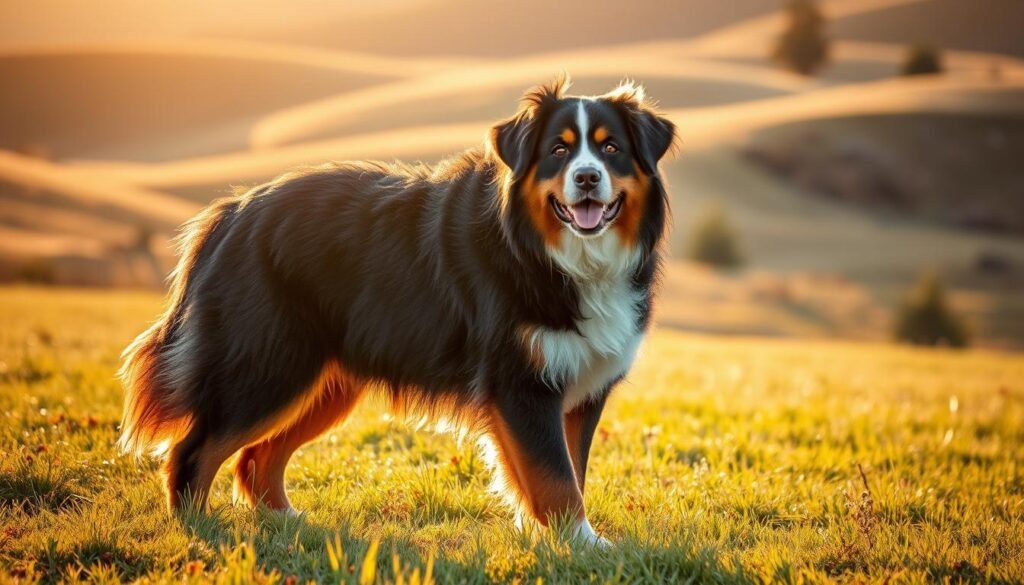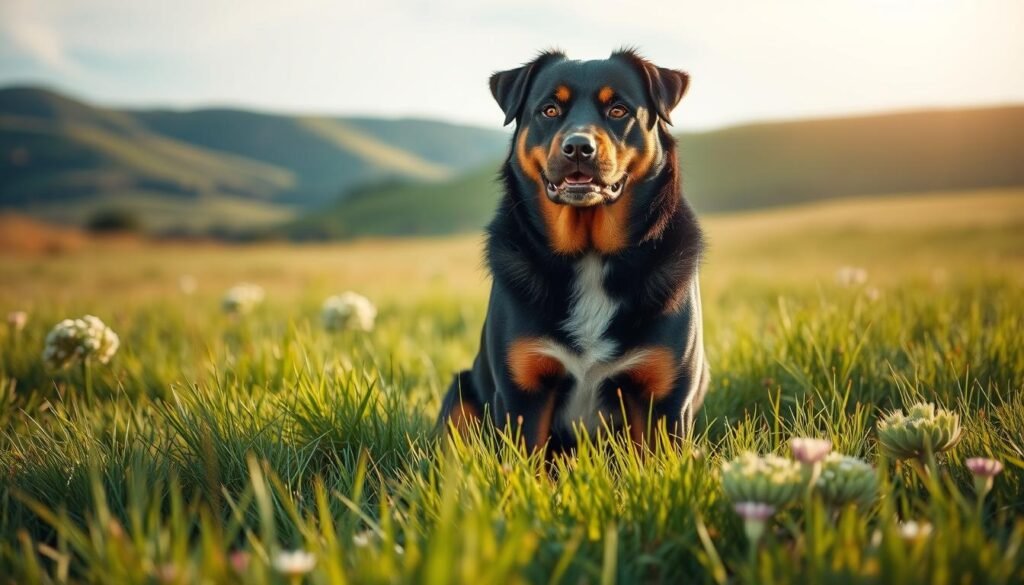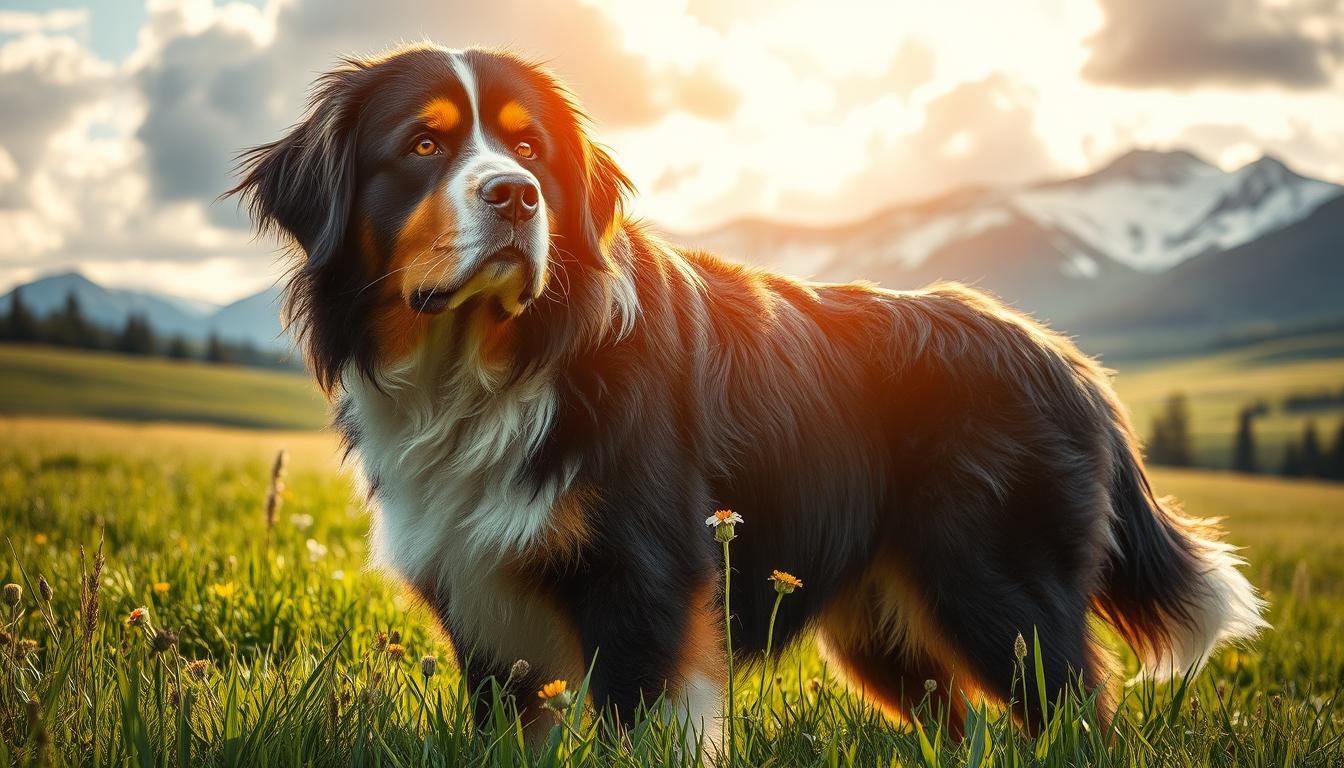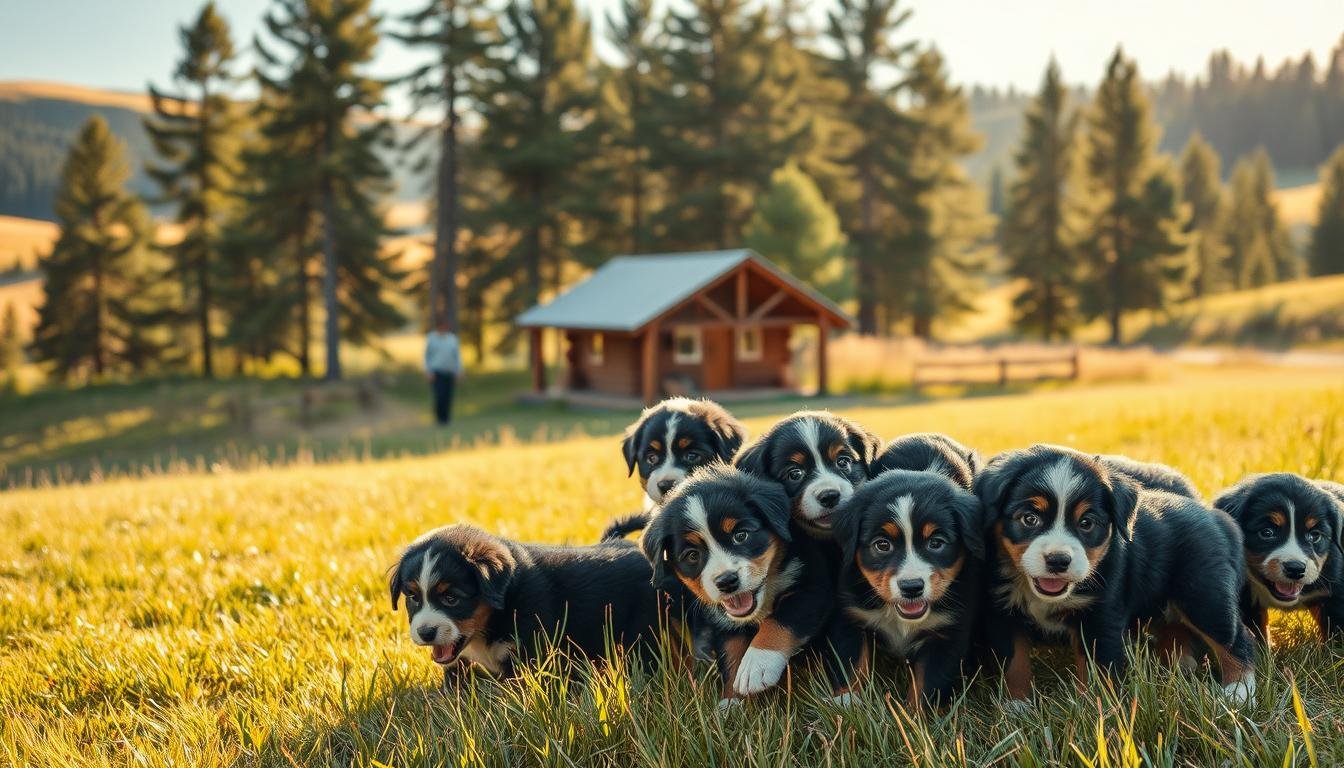Picture this: You walk through the front door after a long day, and 75 pounds of pure devotion comes barreling toward you. A wagging tail thumps rhythmically against the couch, dark eyes sparkle with mischief, and that trademark “I missed you” grin melts your stress away. This isn’t just any pet—it’s a living, breathing security system with a heart of gold.
We’ve all dreamed of finding that perfect balance between protector and cuddle buddy. That’s exactly what you get with this hybrid breed—a fluffy paradox wrapped in muscle and fur. Imagine combining the steadfast loyalty of a classic working breed with the gentle charm of a snowy Alpine companion. The result? A four-legged friend who’ll stand guard at your window and sneak onto your lap during movie night.
What makes these gentle giants so special? Their DNA reads like a superhero origin story. One parent lineage brings watchful intelligence and courage, while the other contributes patience and an almost comical love of family time. They’re not just pets—they’re fuzzy diplomats bridging the gap between bravery and tenderness.
Key Takeaways
- Combines protective instincts with affectionate family-oriented behavior
- Typically weighs between 75-90 pounds with striking coat variations
- Excels as both a companion and property guardian
- Requires consistent training and socialization from puppyhood
- Thrives in homes with space for regular exercise
Introduction: A Unique Canine Companion
There’s a four-legged paradox that redefines the term “best of both worlds.” We’ve spent months decoding hybrid genetics, and what we found would make even Mendel’s pea plants jealous. This isn’t just pet science—it’s a masterclass in nature’s ability to blend brawn with bedtime snuggles.
Our Journey Into Hybrid Canine Traits
Think of these pups as the Swiss Army knives of the animal kingdom. One parent lineage delivers the focus of a chess grandmaster, while the other contributes the warmth of a crackling fireplace. We’ve tracked how their DNA shuffles like a deck of winning cards, creating creatures that can herd sheep at dawn and nap through Bluey marathons by noon.
Our field notes reveal three universal truths about these hybrids:
| Trait | Parent A | Parent B | Hybrid Result |
|---|---|---|---|
| Temperament | Alert Guardian | Social Butterfly | Watchful Cuddler |
| Energy Level | High-Octane | Moderate | Adaptable |
| Social Needs | Selective | Everyone’s BFF | Family-Focused |
What Makes This Mix So Special?
It’s like discovering your favorite sweatpants have hidden tuxedo lapels. These furry friends switch between “I’ll protect you” mode and “scratch my ears now” vibes faster than you can say “treat jar.” Their secret? A genetic cocktail that mixes situational awareness with emotional intelligence—perfect for households wanting both security and Saturday morning pancake partners.
We’ve interviewed dozens of owners who swear their pups have a sixth sense for mood shifts. One recounted how her bernese rottie intercepted a porch package thief… then licked the terrified man’s face. Another described his mix as “part bodyguard, part living weighted blanket.” Now that’s what we call range.
Understanding the rottweiler bernese mountain dog mix: Characteristics & Care

Genetics work in mysterious ways when blending two powerhouse breeds. One moment you’re marveling at a statuesque frame built for alpine treks, the next you’re laughing as your living room becomes an impromptu obstacle course. These hybrids redefine versatility, offering families both a vigilant companion and a sofa-surfing expert.
Defining Physical and Personality Traits
Meet nature’s ultimate multitasker. Their build screams “I bench-press snow tires” while their eyes whisper “five more minutes, please.” We’ve documented pups that transform from serious property patrol to full-blown pancake breakfast beggars before you can say “bacon.”
| Feature | Parent Influence | Hybrid Advantage |
|---|---|---|
| Coat Texture | Thick & Weatherproof | Low-Maintenance Shine |
| Energy Output | High vs Moderate | Self-Regulating |
| Social Behavior | Guardian vs Charmer | Context-Aware |
One owner perfectly described her experience:
“Mine blocked a delivery driver from entering…then presented his belly for scratches.”
This duality makes them ideal for active households craving both security and comic relief.
Their size typically lands between 75-90 pounds – substantial enough to make squirrels think twice, yet compact enough for road trips. Coat patterns range from Rembrandt-worthy markings to sleek monochrome masterpieces. Just don’t be surprised if your “quiet companion” suddenly becomes life coach during hiking adventures.
History and Origin of the Hybrid
The story begins in Alpine valleys and Roman battlefields. We’ve traced the Bernese Mountain Dog’s roots to Swiss dairy farms, where their ancestors hauled cheese carts like furry UPS trucks. Meanwhile, Rottweilers guarded Roman cattle drives – think of them as ancient trucker dogs with better job security.
Modern breeders spotted gold in this genetic mashup. One told us: “We wanted a companion who could watch the kids and the backyard.” The intentional pairing began in the 1990s, creating pups that combine Alpine work ethic with Roman street smarts.
Here’s what makes their heritage special:
| Parent Breed | Historic Role | Modern Contribution |
|---|---|---|
| Bernese | Farm Muscle | Family-Friendly Charm |
| Rottweiler | Livestock Guardian | Situational Awareness |
These hybrids didn’t just inherit skills – they evolved them. Early adopters reported pups that could herd toddlers away from stairs while doubling as couch warmers. One owner joked: “Mine alerts to doorbells and knows when I’ve burnt toast.”
Today’s breeders prioritize health and temperament, ensuring these working-class heroes transition smoothly to suburban life. It’s not just a mix – it’s canine diplomacy between ancient traditions and modern needs.
Breed Characteristics and Temperament

Ever met a living contradiction with paws? These hybrids redefine “gentle giant” through their uncanny ability to switch between sentry mode and snuggle specialist. We’ve clocked their secret weapon: emotional radar that detects bedtime stories and suspicious squirrels with equal precision.
Key Temperament Traits
Their personality cocktail mixes midnight security shifts with daytime talk show host energy. Watch them assess new visitors – tails wagging like metronomes set to “friendly” – while subtly positioning themselves between kids and open doors. One owner marveled: “Mine barks at mail trucks but brings tissues when I sneeze.”
Our research shows they bond like Velcro® with their humans. Expect a shadow that transforms into a 90-pound lap warmer during Netflix binges. Their patience with children? Legendary. We’ve witnessed pups gently herding toddlers away from stairs using only nose nudges and pleading eyes.
Distinctive Physical Features
Their build says “I bench-press firewood” while their expressions whisper “belly rubs, please.” Coat patterns range from Rembrandt-inspired markings to sleek monochrome – perfect for hiding grass stains from backyard adventures. Those sturdy frames (typically 26-28 inches tall) handle snow drifts and sofa naps with equal prowess.
Don’t let the muscular appearance fool you. Their most striking feature? Those liquid-brown eyes that melt resolve faster than ice cream in July. As one breeder quipped: “They could negotiate world peace…if treaties involved ear scratches.”
Health and Wellness Considerations

Let’s talk brass tacks about keeping your furry linebacker in peak condition. While these gentle giants bring endless joy, their size comes with specific needs. We’ve cracked the code on maintaining their vitality through proactive care and smart habits.
Common Health Challenges
Large breeds often face particular vulnerabilities. Through our research, three main concerns emerge:
| Condition | Prevention Strategy | Early Signs |
|---|---|---|
| Joint Issues | Weight management & low-impact exercise | Stiffness after rest |
| Cardiac Concerns | Regular cardiac screenings | Reduced stamina |
| Metabolic Risks | Balanced nutrition | Unexplained weight changes |
One owner shared: “We thought our pup was just being lazy – turns out he needed joint supplements.” This highlights why understanding genetic predispositions matters.
Building Your Prevention Toolkit
Think of vet visits as tune-ups for your living SUV. We recommend:
- Bi-annual checkups (nose-to-tail inspections)
- Tailored exercise plans (swimming works wonders)
- Quality food with glucosamine support
Our golden rule? Catch issues before they catch you. A trusted veterinarian becomes your co-pilot in this journey. Pair professional care with daily belly rubs, and you’ve got a recipe for years of wagging tails.
Nutrition and Diet Tips for Our Canine Friends
Let’s crack the code on fueling your gentle giant without turning mealtime into a science fair project. The right fuel keeps tails wagging and joints springy—think of it as premium unleaded for your furry SUV.
Building Better Bowls
Quality dog food acts like a superhero cape for your companion’s health. Aim for recipes with whole proteins upfront—chicken, beef, or fish should headline the ingredient list. Grains aren’t villains, but simpler carb sources like sweet potatoes often sit better with active breeds.
We’ve seen pups thrive on meals that balance muscle-building nutrients with digestive-friendly fibers. Rotate proteins occasionally to keep taste buds guessing, and always consult your vet before switching diets. Remember, portion control matters—those soulful eyes can turn a cup into a buffet if you’re not careful.
Curious about homemade options? Veterinary nutritionists recommend sticking to vet-approved recipes to avoid missing essential nutrients. Whether you choose commercial or DIY meals, consistency and quality ingredients help your four-legged foodie stay healthy every day.




